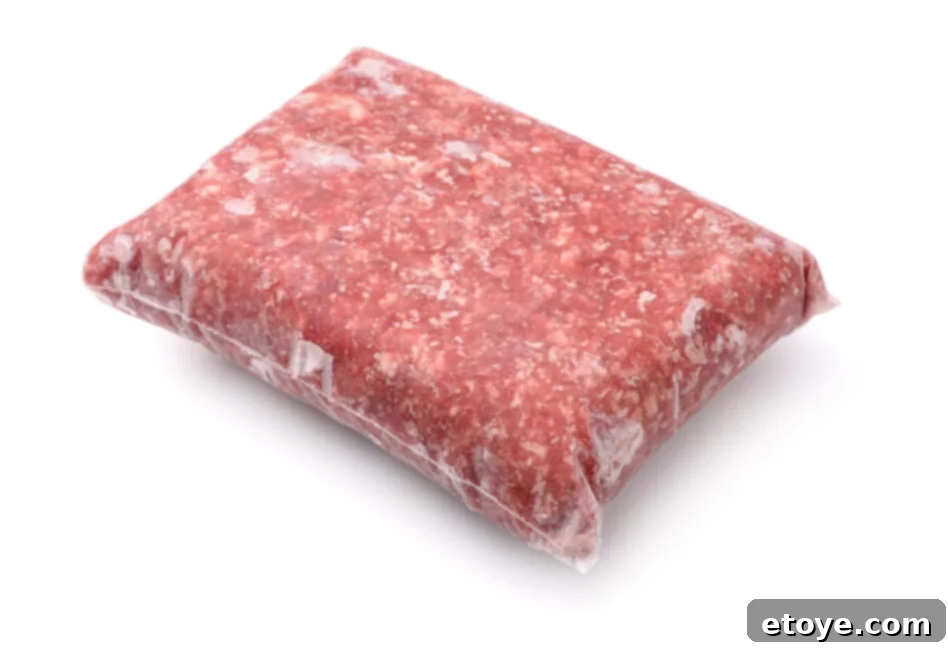Ultimate Guide to Ground Sausage Shelf Life: Storage, Spoilage, and Safety Tips
In every well-managed kitchen, the principles of food waste reduction and smart storage solutions are as fundamental as the foundational ingredients themselves. A cornerstone of this culinary efficiency is a deep understanding of ingredient shelf life, which enables us to store items optimally to extend their usability and prevents premature spoilage. At Steamy Kitchen, our mission is to empower home cooks with practical, effective food storage knowledge, transforming kitchens into hubs of sustainability and safety.
Today, we’re putting a popular and incredibly versatile kitchen staple under the microscope: ground sausage. From savory breakfast links to hearty dinner components, ground sausage is a favorite for its rich flavor and adaptability. But how long does ground sausage truly last, and what are the best practices for keeping it fresh and safe?

Understanding Fresh Ground Sausage and Its Limited Shelf Life
Ground sausage, in its raw, fresh state, is a delicate ingredient with a surprisingly brief window of freshness. Despite its delicious potential, the critical question of “how long does ground sausage last in the fridge?” often goes unasked, leading to potential waste or, worse, foodborne illness. The definitive answer for fresh, raw ground sausage is: ideally, only 1-2 days from the moment you bring it home from the grocery store. This short span underscores the importance of prompt consumption or proper long-term storage.
Why the Short Shelf Life for Ground Meat?
The primary reason for ground sausage’s rapid spoilage lies in its preparation. Grinding meat significantly increases its surface area, exposing more of the meat to oxygen and, crucially, to bacteria. While handling and processing, various types of bacteria, including spoilage bacteria and potentially pathogenic ones like Salmonella and E. coli, can be introduced. Once these microorganisms encounter favorable conditions, particularly temperatures above 40°F (4°C), they multiply at an alarming rate. This rapid bacterial proliferation transforms your delicious ground sausage into a potential health risk much faster than whole cuts of meat.
The “danger zone” for food safety, between 40°F (4°C) and 140°F (60°C), is where harmful bacteria can double in number every 20 minutes. Therefore, immediate and consistent refrigeration is paramount to slow down this process and keep those pesky bacteria at bay.
Spotting Trouble: Unmistakable Signs of Spoilage
Nobody wants to encounter spoiled food, especially meat. Knowing the warning signs of ground sausage that has gone bad is crucial for preventing foodborne illness. Always trust your senses, and if in doubt, throw it out. Here are the telltale indicators:
- Sour or Off Smell: Fresh ground sausage should have a mild, almost neutral smell. If you detect any sour, pungent, rancid, or ammonia-like odors, it’s a clear indicator that spoilage bacteria have taken over. This is often one of the first and most reliable signs.
- Slimy or Sticky Texture: Fresh ground sausage feels moist but firm. If the surface of the sausage feels slimy, sticky, or unusually slick to the touch, it signifies bacterial growth. This sticky film is a byproduct of bacterial activity and is a strong warning sign.
- Visual Cues: Observe the color carefully. Fresh raw ground sausage typically has a pinkish-red hue. Discoloration, such as patches of gray, brown, or even a greenish tint, indicates oxidation and bacterial degradation. Also, look out for any visible mold growth, which can appear as fuzzy white, green, or black spots on the surface. While uncommon in refrigerated fresh ground sausage, it’s a definite sign of spoilage.
- Freezer Burn (for frozen sausage): If you’ve frozen your sausage for an extended period and notice grayish-brown, leathery spots, this is freezer burn. While not a sign of spoilage in terms of safety, it drastically affects the quality, flavor, and texture.
If any of these signs are present, it is safest to discard the ground sausage immediately. The risk of foodborne illness far outweighs the cost of replacing the item.

Mastering Ground Sausage Storage: Extending Freshness and Safety
Maximizing the shelf life of your ground sausage, whether it’s pork sausage, chicken sausage, turkey sausage, or the ever-popular ground breakfast sausage, hinges on implementing proper storage techniques. Thoughtful packaging and temperature control are your best defenses against spoilage and food waste.
Refrigeration: The Immediate Solution
For short-term storage, the refrigerator is your first line of defense. As established, raw ground sausage should be used within 1-2 days. To ensure it remains safe and fresh during this brief period:
- Prompt Refrigeration: Always refrigerate ground sausage as soon as possible after purchase. The less time it spends at room temperature, the better.
- Optimal Placement: Store raw ground sausage in the coldest part of your refrigerator, typically the back of the bottom shelf. This helps maintain a consistent temperature, ideally at or below 40°F (4°C). Avoid placing it in the door, which is prone to temperature fluctuations.
- Secure Packaging: Keep the sausage in its original packaging if it’s intact and airtight. If the packaging is opened or damaged, or if you’ve brought it home from a butcher, transfer the ground sausage to an airtight container or wrap it tightly in plastic wrap followed by aluminum foil. This prevents exposure to air, which causes oxidation and dries out the meat, and also helps contain any potential drips, preventing cross-contamination.
- Prevent Cross-Contamination: Always store raw ground sausage on the lowest shelf in the refrigerator to prevent its juices from dripping onto ready-to-eat foods below. Use separate cutting boards and utensils for raw meat, and thoroughly wash hands and surfaces after handling.
Freezing Ground Sausage: Long-Term Preservation
When the 1-2 day window in the fridge won’t suffice, freezing offers an excellent solution for preserving ground meat quality for an extended period. This method is particularly handy for bulk purchases of raw Italian sausage, breakfast sausage, or any variety you plan to use weeks or months later.
- Preparation for Freezing: For best results, consider portioning the ground sausage into meal-sized quantities before freezing. This allows you to thaw only what you need, reducing waste. Flattening the portions into thin patties or disks can also speed up the thawing process.
- Airtight Packaging is Key: The enemy of frozen food is air, which leads to freezer burn. Wrap the ground sausage tightly in plastic wrap, then place it in a heavy-duty freezer bag, pressing out as much air as possible. Alternatively, use freezer paper or heavy-duty aluminum foil, ensuring no air pockets remain. For the ultimate protection, consider vacuum-sealing the sausage, which can extend its quality significantly.
- Label and Date: Always label your frozen packages with the date of freezing. While ground sausage remains safe indefinitely in the freezer at 0°F (-18°C), its quality (flavor and texture) is best within 1-2 months. Beyond this, it may still be safe but might suffer from diminished taste and quality due to gradual dehydration.
Safe Thawing Methods: Preventing Bacterial Growth
Thawing ground sausage safely is just as important as freezing it properly. Never thaw ground sausage at room temperature, as this allows bacteria to multiply rapidly on the surface while the center remains frozen. The “danger zone” is again a concern here.
- Refrigerator Thawing (Recommended): This is the safest but slowest method. Place the frozen ground sausage on a plate or in a container on the lowest shelf of your refrigerator. Allow ample time for thawing – generally, about 24 hours for every 5 pounds of meat. Once thawed, ground sausage should be cooked within 1-2 days.
- Cold Water Thawing: For faster thawing, place the vacuum-sealed or leak-proof packaged sausage in a bowl of cold water. Change the water every 30 minutes to ensure it remains cold and continues the thawing process. Cook the sausage immediately after it has thawed using this method.
- Microwave Thawing: This is the quickest method but should only be used if you intend to cook the ground sausage immediately afterward. Microwave thawing can cause parts of the meat to begin cooking, and if not cooked promptly, these partially cooked areas can quickly reach the danger zone, promoting bacterial growth. Avoid burning or drying out the edges by using a low power setting and rotating frequently.

Beyond Raw: Storage Guidelines for Different Sausage Types
While fresh ground sausage has a very short refrigerated shelf life, not all sausages are created equal. The processing methods significantly impact how long they last. Understanding these differences is key to smart kitchen management.
Cooked Ground Sausage
Once raw ground sausage has been cooked to an internal temperature of 160°F (71°C), its shelf life extends slightly. Cooked ground sausage, if stored properly, can last in the refrigerator for 3-4 days. To store cooked sausage, allow it to cool quickly (within two hours of cooking) and then transfer it to an airtight container before refrigerating. Cooked ground sausage can also be frozen for 1-2 months, similar to raw, for best quality.
Pre-Cooked Sausages & Hot Dogs
Pre-cooked sausages, such as frankfurters, hot dogs, and some varieties of kielbasa, are processed to have a longer shelf life. Unopened packages of these items can typically last in the refrigerator for up to 2 weeks. Once opened, however, they should ideally be consumed within 1 week to maintain optimal freshness and safety. Always check the “use-by” date on the packaging, as this provides the most accurate guideline.
Cured, Smoked, and Dry Sausages (e.g., Andouille, Salami, Pepperoni)
These varieties undergo specific curing, smoking, or drying processes that remove moisture and inhibit bacterial growth, significantly extending their shelf life. Their storage needs vary greatly:
- Hard, Dry Sausages (e.g., Genoa Salami, Pepperoni): Unopened, these can often be stored at cool room temperature (below 70°F/21°C) for up to 6 weeks or longer. Once cut and exposed to air, they are best stored in the refrigerator, wrapped tightly, for about 3 weeks.
- Semi-Dry Sausages (e.g., Summer Sausage): These are usually sold ready-to-eat and can be stored at room temperature before opening. Once opened, they require refrigeration and should be used within 3 weeks.
- Smoked Sausages (e.g., Andouille, some Kielbasa): These are typically sold fully cooked and can last longer than fresh sausage. Unopened, they might last 1-2 weeks in the fridge. Once opened, treat them like cooked sausage, consuming within 3-4 days.
Always consult the packaging for specific storage instructions, as formulations can vary.
Sausage Patties and Links (Raw)
While often pre-formed, raw sausage patties and links fundamentally consist of ground meat. Therefore, their shelf life in the refrigerator mirrors that of bulk raw ground sausage: 1-2 days. Freezing instructions are also similar: package them individually or with parchment paper between layers in an airtight container or freezer bag for up to 1-2 months for best quality.

Essential Food Safety Practices for Ground Sausage
Beyond simply extending shelf life, the ultimate goal of proper food storage is to prevent foodborne illness. Ground sausage, like all ground meats, requires diligent attention to food safety. Here are critical best practices:
- Maintain Proper Refrigerator Temperature: Your refrigerator should consistently be set at or below 40°F (4°C). Use a refrigerator thermometer to monitor the temperature regularly. Any temperature above this allows for faster bacterial growth.
- Prevent Cross-Contamination: This is paramount for raw ground sausage. Store it in sealed containers or bags on the lowest shelf of your fridge, away from ready-to-eat foods like fruits, vegetables, and cooked dishes. Use separate cutting boards, utensils, and plates for raw meat. Always wash your hands thoroughly with soap and warm water for at least 20 seconds before and after handling raw ground sausage. Clean and sanitize all kitchen surfaces that come into contact with raw meat.
- Cook to the Correct Internal Temperature: All ground meat, including ground sausage, must be cooked to a safe internal temperature of 160°F (71°C). Use a food thermometer inserted into the thickest part of the sausage (if it’s a patty or link) or into the center of a crumbled portion to ensure it reaches this temperature. This kills any harmful bacteria that might be present.
- Observe the “Two-Hour Rule”: Never leave ground sausage (raw or cooked) at room temperature for more than two hours. If the ambient temperature is above 90°F (32°C), this time limit shrinks to one hour. This is due to the “danger zone” where bacteria proliferate rapidly.
- Rapid Cooling of Leftovers: If you have cooked ground sausage leftovers, cool them quickly to minimize bacterial growth. Divide large portions into smaller, shallow containers to facilitate faster cooling. Refrigerate them within two hours of cooking.
Adhering to these food safety guidelines will significantly reduce the risk of foodborne illness and ensure your ground sausage dishes are not only delicious but also safe to eat.
FAQs: Navigating Ground Sausage Storage
Can I freeze ground sausage after cooking it?
Absolutely, cooked ground sausage can be frozen! To ensure safety and preserve quality, first allow the cooked sausage to cool completely, ideally within two hours of cooking. Once cool, transfer it to an airtight container, a heavy-duty freezer bag with all air pressed out, or vacuum-seal it. This prevents freezer burn and maintains flavor. Cooked ground sausage can be frozen for up to 1-2 months for the best taste and texture, though it will remain safe beyond that timeframe if properly stored.
What about pre-cooked sausages or hot dogs?
Pre-cooked sausages, like hot dogs, frankfurters, or some pre-cooked bratwursts, have a significantly longer refrigerator life than raw ground sausage. Unopened packages can typically last up to 2 weeks in the fridge. However, once you open the original packaging, their shelf life shortens considerably; it’s best to consume them within 1 week for optimal freshness and safety. Always refer to the “use-by” or “best-by” date on the packaging.
What about pork, chicken, or turkey sausage? Do their storage rules differ?
While the fat content and flavor profiles vary between pork, chicken, and turkey ground sausage, the fundamental storage rules for raw ground meat remain consistent across all types. The standard rule for fresh, raw ground sausage (regardless of meat type) is to keep it cool, sealed, and dry in the refrigerator for no more than 1-2 days. Always check the “sell-by” or “use-by” date on the packaging, as this provides a crucial starting point for determining freshness. For freezing, the same guidelines apply: airtight packaging and use within 1-2 months for best quality.
How can I tell if frozen sausage has freezer burn?
Freezer burn is a common issue that occurs when frozen food is exposed to air, causing dehydration and oxidation of the meat’s surface. On frozen sausage, freezer burn typically appears as grayish-brown, dry, leathery patches or discoloration. While freezer-burned sausage is generally safe to eat (it does not indicate spoilage in terms of pathogens), its texture will be tough and dry, and its flavor will be noticeably diminished or “off.” To prevent freezer burn, ensure your sausage is wrapped tightly in multiple layers (e.g., plastic wrap then heavy-duty aluminum foil), placed in a heavy-duty freezer bag with all air removed, or ideally, vacuum-sealed before freezing.
Can I eat ground sausage past the use-by date if it was refrigerated?
While the “use-by” date is a good indicator for peak quality and safety, exercising caution is paramount. If your ground sausage is only a day or two past its “use-by” date, and it has been stored consistently at or below 40°F (4°C) in its original packaging or an airtight container, it *might* still be safe to consume. However, this is where your senses become your most important tools. If there is ANY sign of spoilage – a sour smell, a slimy texture, visible discoloration (gray, green, or brown spots), or mold – you absolutely must throw it away. It is never worth risking your health to save a small amount of food. “When in doubt, throw it out” is the safest motto for ground meat.
What is the best way to store cooked sausage leftovers?
After cooking ground sausage, it’s essential to handle leftovers safely. Allow the cooked sausage to cool rapidly within two hours of cooking. To do this efficiently, you can divide larger portions into smaller, shallow airtight containers. Once cooled, seal the containers tightly and place them in the refrigerator. Cooked ground sausage leftovers will maintain their quality and safety for 3-4 days when stored properly in the refrigerator.

The Bottom Line: Be a Food Storage Champion!
Armed with this comprehensive knowledge about ground sausage shelf life, storage, and safety, you are now well-equipped to become a cost-saving, sustainable superhero in your kitchen. Not only will you reduce food waste, but you’ll also ensure that every meal you prepare with ground sausage is as safe as it is delicious. As a bonus, you can share these vital tips with friends and family, potentially safeguarding them from foodborne illnesses too.
The best way to stay safe is to keep a vigilant eye on dates, trust your senses for signs of spoilage, and always err on the side of caution when it comes to ground meat. With this advice in mind, your culinary adventures will always be both safe and scrumptious. Happy cooking, friends!
Explore More Food Storage Insights:
- How Long Does Lunch Meat Last in the Fridge?
- Should Cream Cheese Be Refrigerated?
- Should Butter Be Refrigerated?
- Should Eggs Be Refrigerated?
